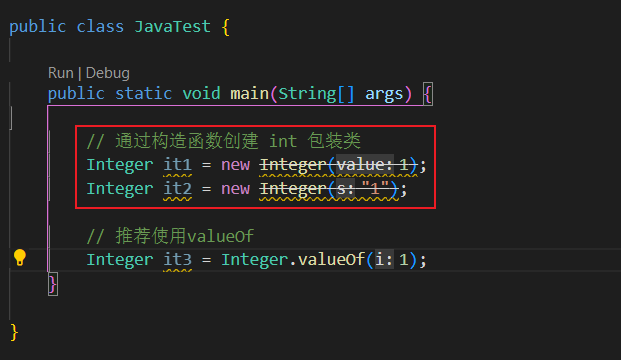>[success] # Integer
1. **Integer**作為 **int**包裝類,包裝了一個**int類型的變量**作為成員變量,主要用于實現對**int類型的包裝**并提供**int類型到String類之間的轉換**等方法
* 進入**Integer 類**中可以看到內部有一個常量 這個常量int 就是被包裝的int 并用其值提供了一些方法

* 創建時候構造函數將傳入基本變量賦值個了value 常量

>[danger] ##### 常用的常量
|常量類型和名稱 |功能介紹|
| --- | --- |
|public static final int MAX_VALUE |表示int類型可以描述的最大值,即2^31-1|
|public static final int MIN_VALUE| 表示int類型可以描述的最小值,即-2^31|
|public static final int SIZE |表示int類型采用二進制補碼形式的位數|
|public static final int BYTES |表示int類型所占的字節個數|
|public static final Class TYPE| 表示int類型的Class實例|
~~~
public class JavaTest {
public static void main(String[] args) {
// 類方法直接調
System.out.println("最大值是:" + Integer.MAX_VALUE); // 2^31-1
System.out.println("最小值是:" + Integer.MIN_VALUE); // -2^31
System.out.println("所表示二進制的位數是:" + Integer.SIZE); // 32
System.out.println("所占字節的個數是:" + Integer.BYTES); // 4
System.out.println("對應int類型的Class實例是:" + Integer.TYPE); // int
}
}
~~~
>[danger] ##### 常用的方法
|方法聲明 | 功能介紹 |
| --- | --- |
|Integer(int value) | 根據參數指定的整數來構造對象(已過時) |
|Integer(String s) |根據參數指定的字符串來構造對象 (已過時) |
|int intValue() |獲取調用對象中的整數值并返回 |
|static Integer valueOf(int i) |根據參數指定整數值得到Integer類型對象 |
|boolean equals(Object obj) |比較調用對象與參數指定的對象是否相等 |
|String toString() |返回描述調用對象數值的字符串形式 |
|static int parseInt(String s) |將字符串類型轉換為int類型并返回 |
|static String toString(int i) |獲取參數指定整數的十進制字符串形式 |
|static String toBinaryString(int i) |獲取參數指定整數的二進制字符串形式 |
|static String toHexString(int i) |獲取參數指定整數的十六進制字符串形式 |
|static String toOctalString(int i) |獲取參數指定整數的八進制字符串形式 |
* 說明 通過**構造函數**方式創建 一個int 包裝類已經過時,更多推薦使用**valueOf**創建

* 案例
~~~
package javaTest;
public class JavaTest {
public static void main(String[] args) {
// 推薦使用valueOf
Integer it3 = Integer.valueOf(1);
Integer it4 = Integer.valueOf("1");
// 通過 intValue 拆包獲取int
int num = it4.intValue();
System.out.println(it3); // 1 字符串類型 System.out.println 會調用類的toString 方法 等同于it3.toString()
System.out.println(num); // 1 數字類型 打印就是基本類型數字1
// --------------128 ------------------------
// Integer類內部 通過靜態內部類提供了一個緩存池,范圍在-128~127之間,如果超過這個范圍 Integer 值都是new出來的新對象
System.out.println(it3 == it4); // true 對象比較是內存地址但是是-128~127之間 因此二者使用是一個指向
System.out.println(it3.equals(it4)); // true 比較內部值是否相同使用equals
Integer it5 = Integer.valueOf(128);
Integer it6 = Integer.valueOf("128");
System.out.println(it5 == it6); // false 對象比較是內存地址 不同 是-128~127之間 創建了兩個新對象
System.out.println(it5.equals(it6)); // true 比較內部值是否相同使用equals
// 類型轉換
int ic = Integer.parseInt("200");
//int ic = Integer.parseInt("200a"); // 編譯ok,運行發生NumberFormatException數字格式異常,因為有字母
System.out.println("字符串轉換為整數的結果是:" + ic); // 200
System.out.println("根據參數指定的整數獲取對應的十進制字符串是:" + Integer.toString(200));
System.out.println("根據參數指定的整數獲取對應的二進制字符串是:" + Integer.toBinaryString(200));
System.out.println("根據參數指定的整數獲取對應的十六進制字符串是:" + Integer.toHexString(200));
System.out.println("根據參數指定的整數獲取對應的八進制字符串是:" + Integer.toOctalString(200));
}
}
~~~
* Integer類內部 通過靜態內部類提供了一個緩存池,范圍在-128~127之間,如果超過這個范圍 Integer 值都是new出來的新對象

>[info] ## 裝箱和拆箱
1. 自動裝箱: 基本數據類型->包裝類。對應Integer.valueOf(int i);
2. 自動拆箱:包裝類->數據類型。對應Integer.intValue();
~~~
public class JavaTest {
public static void main(String[] args) {
// 自動裝箱: 基本數據類型->包裝類。對應Integer.valueOf(int i);
// 自動拆箱:包裝類->數據類型。對應Integer.intValue();
Integer it5 = 100; // 直接通過賦值運算符實現自動裝箱
int ib = it5; // 直接通過賦值運算符實現自動拆箱
// 裝箱案例
Integer[] it = new Integer[5];
it[0] = 1; // 雖然接受的是Integer 類型 但是賦值int 類型時候進行了裝箱
// 拆箱案例
Integer it1 = 100;
int num = 100;
System.out.println(it1 == num); // true 因為做了拆箱實際 運行 it1.intValue()==num
/**
* 下面代碼實際 運行效果
* Integer i = Integer.valueOf(50);//java自動裝包
* Integer j = Integer.valueOf(60);//java 自動裝包
* System.out.println(i.intValue()+i.intValue());//java 自動拆包
*/
Integer i = 50;
Integer j = 60;
System.out.println(i + j);
// 注意 -128 - 127 問題,當Integer i1 = 50 執行時候進行了裝箱
// 進行了裝箱 執行了Integer.valueOf(50); 因為valueOf 會命中緩存
// 所以 i1 == i2 為true ,i1 == j2 i1會進行拆包,把值轉為int類型 因此是true
// k3 通過構造創建的因此沒有緩存說法 因此i1 == k3 為false
Integer i1 = 50;
Integer i2 = 50;
int j2 = 50;
Integer k3 = new Integer(50);
System.out.println(i1 == j2);// true
System.out.println(i1 == i2);// true
System.out.println(i1 == k3);// false
}
}
~~~
>
- windows -- 環境變量
- Vscode -- 編寫java
- 初始java
- java -- 關鍵字
- 編寫第一個java程序
- java -- 注釋
- 計算機存儲 -- 進制
- java -- 類型
- java -- 變量
- 數字類型
- 布爾類型
- 字符類型
- 類型轉換
- 雙等比較是什么
- java -- 運算符
- 算數運算符
- 字符串拼接
- 關系/比較運算符
- 自增減運算符
- 邏輯運算符
- 三目運算
- 賦值運算符
- 移位運算符
- 位運算符
- 運算符優先級
- java -- 流程控制語句
- if /else if /if -- 判斷
- switch case分支結構
- for -- 循環
- 用雙重for循環
- while -- 循環
- do while -- 循環
- 案例練習
- java -- 數組
- 數組的存儲
- 數組的增刪改查
- 數組的特點
- 數組案例
- 二維數組
- 數組的工具方法
- java -- 方法
- java -- 方法的重載
- java -- 方法的調用流程
- java -- 類方法傳參注意事項
- java -- 方法練習案例
- 對比 return break continue
- for each循環
- java -- 基礎練習
- java -- 面向對象
- java -- 創建類和對象
- java -- 訪問控制符
- java -- 類成員方法
- java -- 構造方法
- java -- this
- java -- 封裝
- java -- 對象內存圖
- java -- 創建對象案例
- java -- static
- java -- 繼承
- super -- 關鍵字
- java -- 構造塊和靜態代碼塊
- java -- 重寫
- java -- final
- java -- 多態
- java -- 抽象類
- java -- 接口
- 引用類型數據轉換
- 綜合案例
- java -- 內部類
- java -- 回調模式
- java -- 枚舉類型
- java -- switch 使用枚舉
- java -- 枚舉方法使用
- java -- 枚舉類實現接口
- java -- javaBean
- java -- package 包
- java -- import
- java -- 遞歸練習
- java -- 設計模式
- 單例模式
- java -- 注解
- java -- 元注解
- Java -- 核心類庫
- java -- 處理字符串
- Java -- String
- String -- 常用方法
- String -- 正則
- Java -- StringBuilder 和 StringBuffer
- 知識點
- Java -- StringJoiner 字符串拼接
- 練習題
- 字符串的總結
- Java -- 包裝類
- Integer
- Double
- Boolean
- Character
- java -- 集合類
- java -- util.Collection
- Iterator接口
- java -- util.List
- java -- ArrayList
- java -- util.Queue
- java -- util.Set
- java -- util.Map
- java -- util.Collections
- Java -- Math
- Java -- java.lang
- Java -- Object
- Java -- 獲取當前時間戳
- Java -- 異常
- Java -- java.util
- java -- Date
- java -- Calender
- Java -- java.text
- Java -- SimpleDateFormat
- Java -- java.time
- Java -- java.io
- java -- io.File
- java -- 泛型
- IDEA -- 用法
